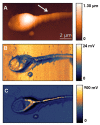Scanning Probe Microscopies: Imaging and Biomechanics in Reproductive Medicine Research
- PMID: 33917060
- PMCID: PMC8067746
- DOI: 10.3390/ijms22083823
Scanning Probe Microscopies: Imaging and Biomechanics in Reproductive Medicine Research
Abstract
Basic and translational research in reproductive medicine can provide new insights with the application of scanning probe microscopies, such as atomic force microscopy (AFM) and scanning near-field optical microscopy (SNOM). These microscopies, which provide images with spatial resolution well beyond the optical resolution limit, enable users to achieve detailed descriptions of cell topography, inner cellular structure organization, and arrangements of single or cluster membrane proteins. A peculiar characteristic of AFM operating in force spectroscopy mode is its inherent ability to measure the interaction forces between single proteins or cells, and to quantify the mechanical properties (i.e., elasticity, viscoelasticity, and viscosity) of cells and tissues. The knowledge of the cell ultrastructure, the macromolecule organization, the protein dynamics, the investigation of biological interaction forces, and the quantification of biomechanical features can be essential clues for identifying the molecular mechanisms that govern responses in living cells. This review highlights the main findings achieved by the use of AFM and SNOM in assisted reproductive research, such as the description of gamete morphology; the quantification of mechanical properties of gametes; the role of forces in embryo development; the significance of investigating single-molecule interaction forces; the characterization of disorders of the reproductive system; and the visualization of molecular organization. New perspectives of analysis opened up by applying these techniques and the translational impacts on reproductive medicine are discussed.
Keywords: AFM; IVF; SNOM; blastocysts; embryos; oocyte; ovary; spermatozoa.
Conflict of interest statement
The authors declare no conflict of interest.
Figures




References
-
- Pascolo L., Bedolla D.E., Vaccari L., Venturin I., Cammisuli F., Gianoncelli A., Mitri E., Giolo E., Luppi S., Martinelli M., et al. Pitfalls and promises in FTIR spectromicroscopy analyses to monitor iron-mediated DNA damage in sperm. Reprod. Toxicol. 2016;61:39–46. doi: 10.1016/j.reprotox.2016.02.011. - DOI - PubMed
-
- Pascolo L., Zupin L., Gianoncelli A., Giolo E., Luppi S., Martinelli M., De Rocco D., Sala S., Crovella S., Ricci G. XRF analyses reveal that capacitation procedures produce changes in magnesium and copper levels in human sperm. Nucl. Instrum. Methods Phys. Res. Sect. B Beam Interact. Mater. Atoms. 2019;459:120–124. doi: 10.1016/j.nimb.2019.09.005. - DOI
-
- Zupin L., Pascolo L., Gianoncelli A., Gariani G., Luppi S., Giolo E., Ottaviani G., Crovella S. Ricci Synchrotron radiation soft X-ray microscopy and low energy X-ray fluorescence to reveal elemental changes in spermatozoa treated with photobiomod-ulation therapy. Anal. Methods. 2020;12:3691–3696. doi: 10.1039/D0AY00960A. - DOI - PubMed
-
- Pachetti M., Zupin L., Venturin I., Mitri E., Boscolo R., D’Amico F., Vaccari L., Crovella S., Ricci G., Pascolo L. FTIR Spectroscopy to Reveal Lipid and Protein Changes Induced on Sperm by Capacitation: Bases for an Improvement of Sample Selection in ART. Int. J. Mol. Sci. 2020;21:8659. doi: 10.3390/ijms21228659. - DOI - PMC - PubMed
Publication types
MeSH terms
Grants and funding
LinkOut - more resources
Full Text Sources
Other Literature Sources
Miscellaneous

